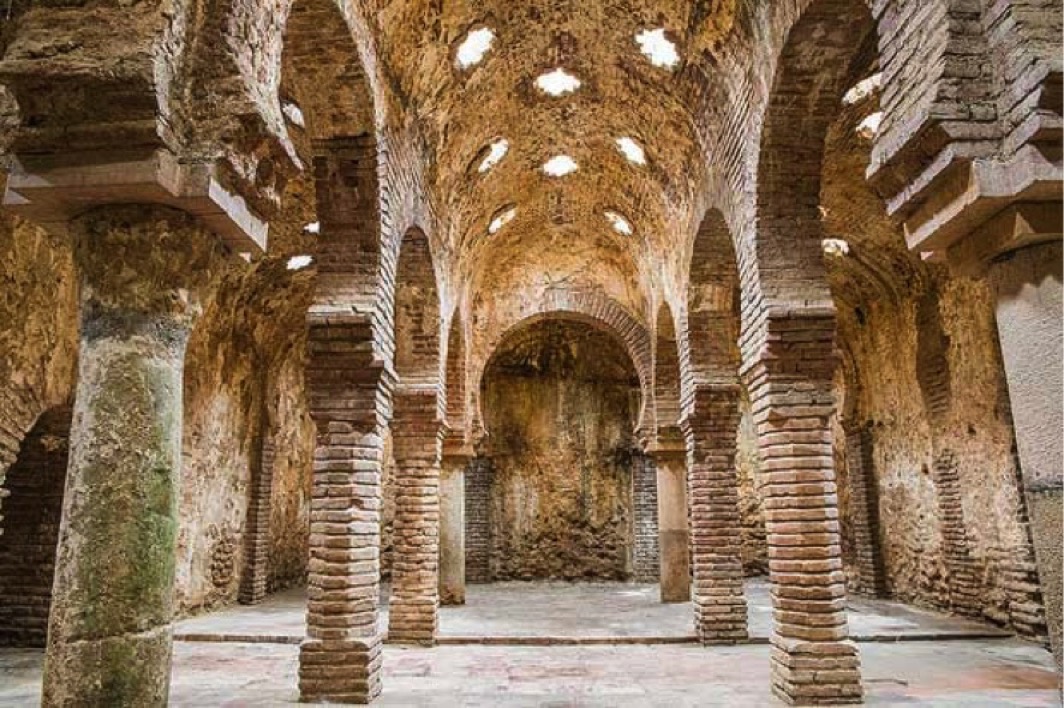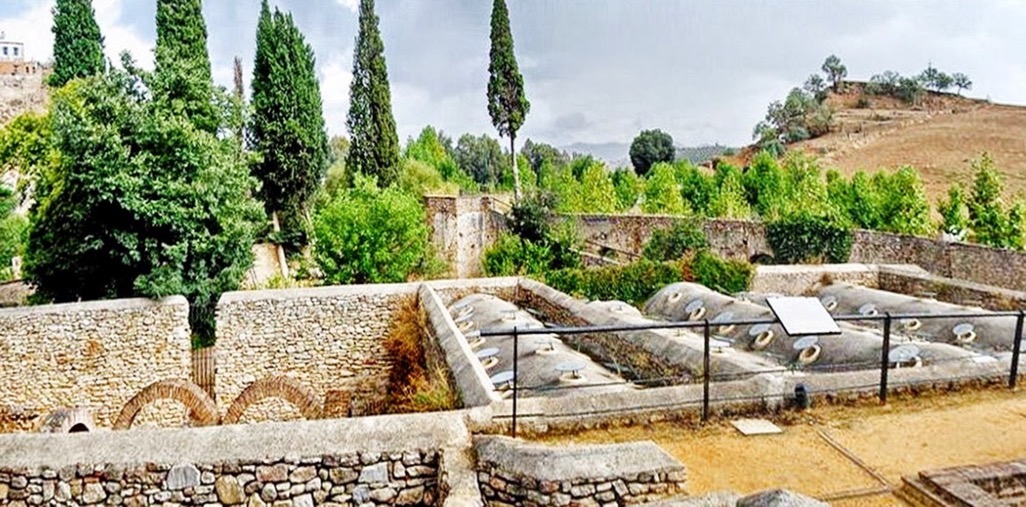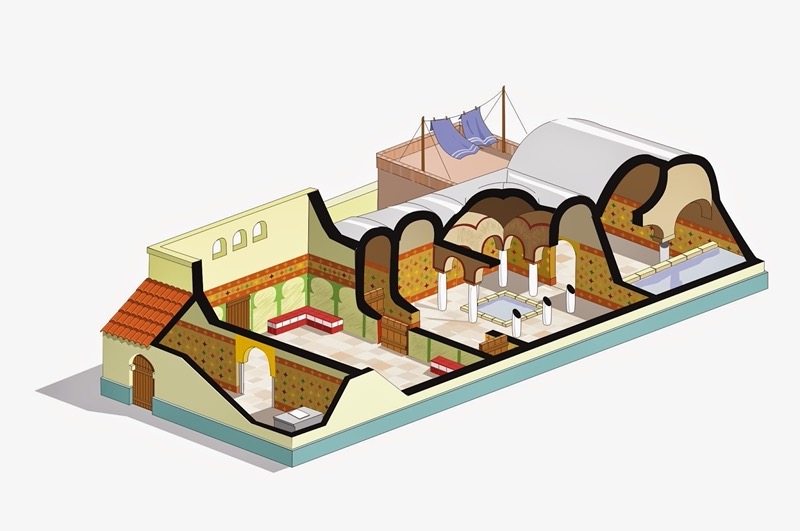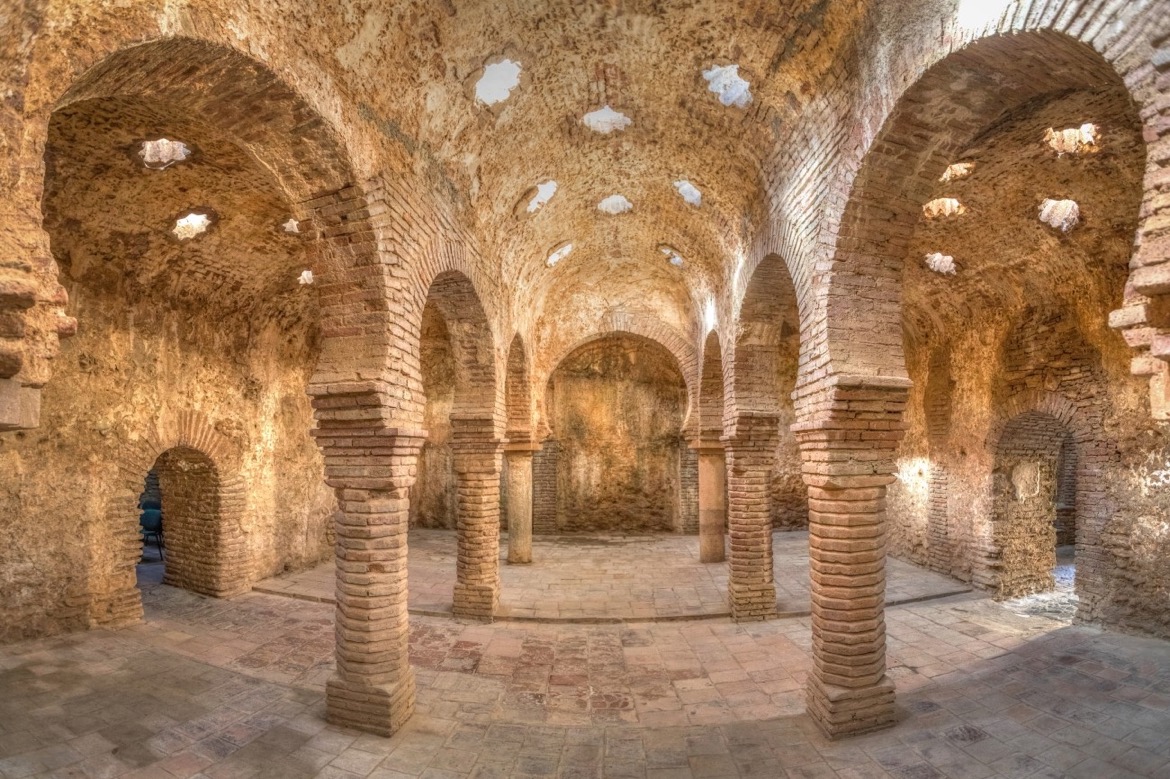Baños Árabes
last update: 31 December 2020

According to the documentation los Baños Árabes in the San Miguel neighbourhood of Ronda are one of the best preserved, largest and most interesting in all of Spain. Unfortunately the baths have lost all their decoration of marble, plasterwork and mosaics, which I must admit makes for a much duller visit (dare I say an intellectual rather than visual experience). However their hydraulic system is practically intact, so you can get a fairly good idea about the general operation of the baths.

In Ronda the baths were located in the old Islamic suburb, on the outskirts of what was the Muslim medina (current called San Miguel). According to tradition, visitors had to purify themselves before entering the city, so the baths were located next to the Puerta del Puente, next to the Puente de las Curtidurías.
The name Curtidurías refers to the tanneries which were installed next to the bridge so they could easily access the river. In fact they exploited the so-called Culebras stream, which was separated from the Guadalevín river by a retaining wall. Just as the baths are preserved so are the tanneries, because after the Christian conquest of the city the baths were converted to tanneries. Some reports mention that the place had already been home to the earlier Roman baths.
For the baths there was a weir and a wheel to raise the water to a small aqueduct that carried the water into the interior of the building. Some reports mention that you can still see the place where the tower was, powered by a donkey that walked in circles raising ceramic jugs full of water and tipping the contents into the small aqueduct.
The tradition of Arab baths has its roots in Roman thermae, which were common in all settlements during the time of the Roman Empire. The custom became deeply rooted in all the territories conquered by the Romans and was adopted by the Islamic culture that came afterwards. As Byzantine territories in the Middle East were assimilated by the Umayyad dynasty, they adopted the traditions of the public baths. Early hammams were built in the 8th century by the Umayyad rulers who established their capital in Damascus. As Islam expanded so the architecture and bathing habits changed from Roman to Islamic. Roman thermae were usually very large, including libraries, gymnasiums, exercise grounds, gardens, tanning rooms, ball courts, and even concert halls. But in addition there were also balnea, smaller privately owned Roman baths, located in great numbers in the larger cities.
The working of the hammam or Arab baths is very similar to that of the Roman thermae, with the space divided into several rooms. There was a dressing-room or al-bayt al-maslaj (the apodyterium in the Roman baths), a cold room or al-bayt al-barid (the frigidarium), a warm room or al-bayt al-wastani (the tepidarium), and a hot room or al-bayt al-sajun (the caldarium). Heat was produced in a service room adjacent to the latter, which housed the boiler or al-burma, and a place for storing fuel.
Through Greek and Roman sources we know the peninsula was inhabited by Tartessians, Iberians, Celts, "peoples of the plateau", and tribes on the Cantabrian fringe (at the time this included Asturians, Cantabrians, Galicians and Basques). In the region there are remains of so-called "castreñes saunas", spaces intended for thermal baths. It is not clear if they were for recreational or ritual activities, or related to health in one way or another. They certainly preceded the Roman baths, and thus also the Arab baths. The earliest date from the Iron Age, and many are strikingly similar in both proportions and in the selection of sites.
The idea was that alternating heat and cold opened up and cleaned the pores and was one of the greatest pleasures in Islamic daily culture. However, there are certain differences between Arab and Roman baths. The Islamic hammam in fact evolved more from the balnea tradition.

For example, Arab baths are usually smaller and laid out in parallel to form a square or a rectangle, they had no niches but alcoves separated by arches and, of course, they reflected Islamic tastes and preferences in their architectural style and building methods. Also the cold plunger pool, important in the Roman bath, disappeared in the Islamic hammam. The idea of immersing in a shared pool was replaced by collecting the condensed steam in small pools and pouring water over the body to wash, which also had its religious significance. The heating was underfloor and the steam was created by flushing water of the hot floor slabs, some reports mention that the floor was perforated with small holes.

Today you often see Arab baths presented with large swimming pools, etc., but the reality is that in the hammam you went from the changing room to the cold bathroom, where they might bath in cold water. This might be in bathtubs, but was more likely to be with ice cold water poured over them. There were no pools in which you could swim. In the warm room you could get a massage, and it was where people would spend most of their time. Then there was the hot bathroom, which was more like a steam bath. It was this room that had the heated floor, and steam was produced by pouring water on the floor. There were also a small number of private room that could be booked for meetings. The rich would have expected to see marble and tiles, but most of the baths were just build of brick and lime render. Since most Arab baths were not particularly big, there could be few hundred of them in a major city. Most were not particularly attractive buildings (some could be quite humble), and being hidden away meant that there was not much light inside (most came from skylights).
In addition Arab baths were usually built adjacent to or as part of a mosque, as the Koran says that ablutions should precede prayer. Also the proceeds from the baths were usually used to help finance the adjacent mosques. In any case, Arab baths, like thermae, were not only places destined for bodily hygiene, but also in time became places for people to gather, talk and hold meetings, fulfilling an important social function difficult to imagine today.
The hammam was particularly important for women because it was often the only place they could meet outside the home. The undressing room had social significance as a meeting place for the arrangement of marriages and as a venue for the celebration of key life events such as pre-wedding ceremonies, the birth of a child and the circumcision of a son. The undressing room was also where the latest neighbourhood news was exchanged and it provided a relaxing space for men where both business and political events were frequently discussed.
The bathing ritual in the hammams in different parts of Europe followed almost the same sequence with slight variations. The body was normally never entirely exposed to the gaze of other bathers and was traditionally wrapped in a fouta, a cotton towel. After sweating in the hot room and then having the body scrubbed by a hammam attendant, the bather would wash their body facing the individual stone or marble washing basin, scooping water with a brass bowl commonly known as tassa and pouring water over the whole body. The bather would then sit directly on the warm stone or marble floor or on wooden stools. Washing private parts of the body took place in semi-dark niches for a higher degree of privacy. The bather would move around spaces of different heat and steam intensity, but also of different levels of natural light and privacy, in order to perform different body treatments. The scrubbing of the body took place either on the floor or on the large heated marble table under the pierced dome or vault of the hot room. The bather might rest for a short while between the different stages of washing by sitting in the transition room, separating the undressing hall from the bathing spaces.
If you are interesting in the way the hammam evolved across the Middle East you can check out this article, and this webpage is home to a very useful discussion on los Baños Árabes, including lots of really good photographs from examples all over Spain.
In many cases, little is known concerning the exact history of the Arab baths. Records often start with a property registry conducted after the Catholic conquest of the city. It is thought that the baths in Ronda date from the 13th or 14th century. Generally the baths were not retained after the conquest because they were considered a potential hazard as a point where Moriscos could gather to prepare uprisings.
This might sound far fetched today, but there was a Arab text that went:-
The hammam is a place where men, gathered together, are all alike, whether they are raised as gentlemen or not
Man rubs shoulders with people who are not his friends,
and his enemy may be his partner"
We should not overly stress the egalitarian aspect of an Arab bath, since there were clear ways to underline social differences. It depended upon the hammam used, the accompaniments carried out, the quality of services required, the treatment received by the staff, each entailing a financial outlay. But nevertheless the hammam was perhaps the only place where customs and traditions could be relaxed.
One aspect that was retained by the Catholic victors were the public toilets. They remained open and were frequented by both the Muslim, Christian and the Jewish populations, with different days reserved for men and women. It was Alfonso X who had decided "We shall order that no Jew be daring to bathe in one with Christians", but it would appear that toilets were different. However, it should be noted that the Catholic Monarchs still went ahead and retained the Baño de Comares de la Alhambra for their personal use.
It was often in the 19th century that a certain romantic interest emerged for Ronda's Arab past, as with many Spanish cites at that time. It has been written that one of the owners of the baths, a certain Vito Zini, maitre de hotel at the Reina Victoria in Ronda, installed a kiln and between the wars started to produce fake Islamic objects that he claimed had been discovered there. The baths were only properly surveyed, restored and opened to the public in the latter part of the 20th century.
Visiting you can see the entrance hall where the men would changing and rest. There is the main, warm room, with the star-shaped skylights with would have had inserts of coloured glass. There is the hot room, and the separate furnace room which would deliver hot air in underfloor ducts. And there is also a cold room.
